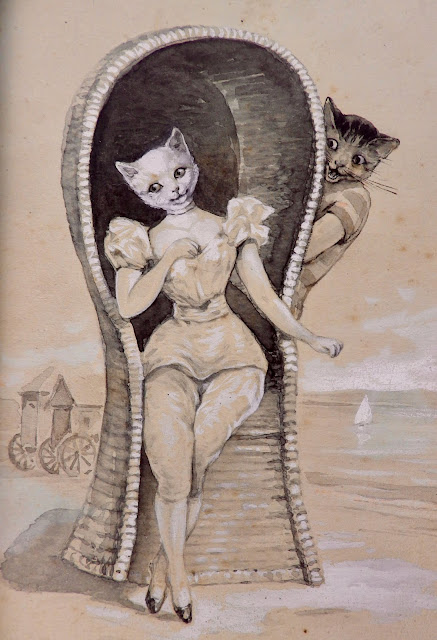Over many years of collecting, I have added assorted other bathing-beauty themed items along with my china and bisque belles. While straightening out a display case, I realized I had acquired a small sample of cigarette cases, each featuring a lovely lady. This sterling sliver cigarette case with its nubile Nereid is typical of the art nouveau offerings by the Unger Brothers, a jewelry and silver manufacturing firm established in New Jersey in the 1870s. The firm became renown in the late 1800s and early 1900s for its elaborate and exquisite repousse art nouveau pieces, ranging from petite pins to entire vanity sets, and of course cigarette cases. The company's work often featured voluptuous belles, clad in little more than their own flowing tresses, floating in water or riding upon waves. This stunning sterling sylph is 3.25 inches high and 2.5 inches wide. The case is stamped on an internal bar or gate meant to hold the cigarettes in place with the Unger Brothers intertwined "U" and "B." The case was clearly intended for a man, not only because of its bare buxom belle, but the back is also curved to fit snuggly in a man's pocket.

Featuring a more modestly clad bather in fired enamel, this case is 3.25 inches by 2.25 inches Inside it is stamped with "800," which means it is 800 parts silver to 200 parts of alloy (sterling silver is denoted by "925"), as well as an unidentified maker's mark. I suspect this piece is Italian, as prior to the establishment of hallmark regulations in the 1934, much Italian silver carried only mark establishing purity, sometimes along with a city or maker's mark. Also, many years ago while exploring the jewelry and antique shops on the Ponte Vecchio in Florence I saw a case with a nearly identical, although badly damaged, enamel scene.

Another reason I think this case may be Italian is that the scene was "inspired" (a nice way of saying used without bothering about little things like copyright protection) by this postcard I believe was designed by Italian artist Giovanni Guerzoni, who worked in Milan from 1897 through the 1920s. He is known for his soft impressionistic landscapes, portraits of pretty woman, and romantic themes.

There has been a flood in recent years of fake enamel cigarette cases, often with highly sought after erotic or historic themes, many selling for hundreds, even thousands, of dollars. The case itself is often antique sterling or alpaca (a silver metal alloy created using nickel, copper, tin, and zinc, and often used as a silver substitute). A ceramic plaque or laminated print is then inset into the cover or simply attached as a plaque on top. This is how you can find an "authentic antique" erotic cigarette case with a British assay mark from the 1920s featuring a 1940s pinup girl! The vast majority of antique cases were decorated with vitreous enamel, in which colored powered glass is fused to a surface by firing. Most of the reproductions are using porcelain plaques or laminated pictures, often with images created using offset printing, in which the picture is made up of regularly placed dots. The printed images used on the modern cases often are from from well-known Victorian or art nouveau paintings, or even old postcards that include the artist's signature (I have seen several of these cases using postcards designed by
Luiz Usabal, whose work has been featured on this blog). These artists designed the postcard, not the case! As you can see in this enamel example, the signature was conveniently omitted. The enamel work is softer and looser than the image on the postcard, with subtle changes in the scene and coloring. A close up shows the enamel surface, including the expected wear and scratches, as these cases were meant to be carried about in pockets and purses and used regularly. The enamel looks more like a painting than a print.

A close up of the postcard reveals the dots used on offset printing to create the image. If you are in the market for an antique enamel cigarette case, check for these dots. Also, do not be shy about questioning the seller regarding whether the image is original to the case and requiring that the seller the state on the invoice that the entire case is an original antique with vitreous enamel decoration.
An unusual alpaca case with the enamel filling an engraved design. The case is 3.75 inches by 3 inches and inside has metal eyelets that would have one been strung with elastic to hold the cigarettes in place. This was a much-used case and it appears at one point someone tried to efface an image or initials in the upper left corner. Despite the surface wear and scratches, the details are still delightful, including her colorful cushions and the dainty pair of slippers sitting on the rug near her feet.
This case, probably dating from the 1910s or 1920s, was an inexpensive alternative to sterling cases with hand-painted enamels. The image is a hand-tinted photograph printed on celluloid and resembles those found on little advertising mirrors and pins from the period. Made of an inexpensive silver-tone metal, it is stamped "Germany" on the internal bar or gate. It is 3.5 inches by 2.75 inches.
















